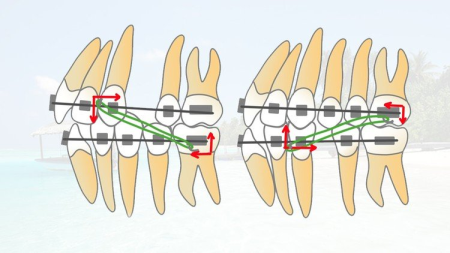Orthodontic biomechanics and anchorage

Genre: eLearning | MP4 | Video: h264, 1280x720 | Audio: aac, 44100 Hz
Language: English | VTT | Size: 1.09 GB | Duration: 3 section | 9 lectures | (2h 32m)
Deep bite correction.
What you'll learn
Orthodontic tooth movement
Biomechanics of tooth movement
Types of dental movements: Tipping, Translation, Root movement, Rotation, Intrusion, Extrusion
Correction of bilateral posterior open bite. Correction of anterior cross bite. Use of V bend. Diastema closure
Indications for anchorage
Types of anchorage. Minimal Anchorage. Moderate Anchorage. Maximum or Severe Anchorage. Absolut Anchorage
Requirements
Interested in becoming an orthodontic specialist
Description
This course will take you from zero to hero of the following orthodontic topics: Orthodontic tooth movement; Biomechanics of tooth movement and Anchorage.
Here are the main headlines that this course covers:
Orthodontic tooth movement
1. Role and structure of periodontal ligament
2. Theory of tooth movement
3. Optimal orthodontic force
4. Tissue response to orthodontic force
4.1 Changes in the pressure zone
4.2 Changes in the tension zone
5. Stages of tooth movement
6. Types of force based on magnitude and force decay.
7. Effects on drugs on the response to orthodontic force
Biomechanics of tooth movement
1. Introduction
2. Laws of Newton
3. Definition of force
4. Definition of center of resistance
5. Center of rotation
6. Definition of moment
7. Types of dental movements
7.1 Tipping
7.2 Translation
7.3 Root movement
7.4 Rotation
7.5 Intrusion
7.6 Extrusion
8. Definition of a couple
9. Static equilibrium
10. Action and reaction
11. Deep bite correction
12. Correction of bilateral posterior open bite
13. Correction of anterior cross bite
14. Use of V bend
15. Diastema closure
Anchorage
1.Introduction
1.Definition for anchorage
2. Classification of anchorage
2.1 Intraoral or extraoral
2.2 Intramaxillary and intermaxillary
2.3 Type A, Type B, Type C
3. Intramaxillary anchorage
Anchorage preparation
Soft tissue anchorage
Free anchorage
4. Intermaxillary anchorage
5. Extraoral anchorage
6. Indications for anchorage
7. Factors to consider deteing the type of anchorage
8. Tips to reinforce posterosuperior anchorage
9. Tips to reinforce anteroinferior anchorage
10. Types of anchorage
10.1.1. Minimal Anchorage.
Stops.
Tip back.
Arch wire tie back.
Toe-in, Toe-Out.
Retro-ligature.
Intermaxillary elastics.
Lip Bumper.
10.2. Moderate Anchorage.
Nance Button.
Transpalatine Arch (TPA).
Lingual Arch
10.3. Maximum or Severe Anchorage.
Chromosome arch.
Transpalanance
10.4. Absolut Anchorage
Who this course is for:
General dentists and post-graduate students
Dental students
DOWNLOAD
uploadgig
https://uploadgig.com/file/download/Da4Fa25b75209b0b/hJ0l27Bt__Orthodonti.part1.rar
https://uploadgig.com/file/download/6C49d52835a69E2e/hJ0l27Bt__Orthodonti.part2.rar
rapidgator
https://rapidgator.net/file/d33c169afdf13f5f35899270de6367b3/hJ0l27Bt__Orthodonti.part1.rar
https://rapidgator.net/file/e2e51654ec2b7d67507fe5c63d29c0fa/hJ0l27Bt__Orthodonti.part2.rar
nitroflare
http://nitroflare.com/view/4A4331E12AFE5E9/hJ0l27Bt__Orthodonti.part1.rar
http://nitroflare.com/view/1F2FBA34E0F48FD/hJ0l27Bt__Orthodonti.part2.rar


Information
Users of Guests are not allowed to comment this publication.




